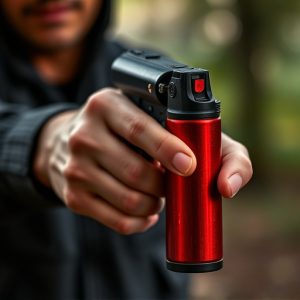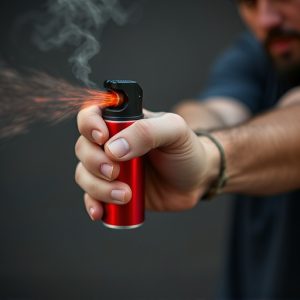Pepper Spray Weapon: Effective Law Enforcement, Optimal Storage & Safety
The best storage temperature for pepper spray is between 50-70°F (10-21°C) to maintain its p…….
The best storage temperature for pepper spray is between 50-70°F (10-21°C) to maintain its potency and effectiveness. This range preserves the active ingredient, capsaicin, ensuring its ability to disable aggressors. Storage considerations include avoiding extreme temps, direct sunlight, maintaining humidity, and using secure containers. Law enforcement receives specialized training on deployment techniques and safety protocols, adhering to regulations for optimal equipment preservation and officer protection.
“Pepper spray, a powerful law enforcement tool, has evolved as a non-lethal force option. This article delves into the intricacies of pepper spray weaponry, offering a comprehensive guide for officers and enthusiasts alike. We explore its composition, sensitivity, and how it translates to on-the-ground effectiveness. Furthermore, best practices for storage, safety precautions, training, and regulatory compliance are highlighted, including optimal temperature considerations for longevity. By understanding these key aspects, users can maximize the potential of pepper spray while adhering to legal standards.”
- Understanding Pepper Spray Composition and Sensitivity
- Law Enforcement Usage and Effectiveness Considerations
- Storage Conditions for Optimal Longevity and Performance
- Safety Precautions and Training Requirements
- Regulatory Compliance and Legal Implications
Understanding Pepper Spray Composition and Sensitivity
Pepper spray, a potent force multiplier in law enforcement arsenal, is composed primarily of capsaicin, the active ingredient derived from chili peppers. This chemical irritates the eyes and respiratory system, temporarily disabling an aggressor. Understanding pepper spray composition is crucial for optimal performance; capsaicin’s stability varies with temperature, making the best storage temperature for pepper spray a key factor. Ideally, it should be stored in a cool, dry place, typically between 50-70°F (10-21°C), to maintain its efficacy and ensure maximum shelf life. Deviations from this range can lead to reduced potency as capsaicin breaks down more rapidly at higher or lower temperatures.
Sensitivity to pepper spray varies among individuals based on factors like body size, fitness level, and tolerance to irritants. While it is designed to subdue most adults, its effectiveness against children, the elderly, and those with respiratory conditions may be diminished. Law enforcement officers are trained to handle these situations, using appropriate force levels to ensure public safety while minimizing harm. Proper storage, combined with awareness of individual sensitivities, contributes significantly to the safe and effective deployment of pepper spray in law enforcement operations.
Law Enforcement Usage and Effectiveness Considerations
Law enforcement officers often rely on pepper spray as a non-lethal force option, particularly in crowd control and to subdue resistant individuals. However, its effectiveness is contingent on several factors, including proper usage techniques and environmental conditions. One critical consideration is temperature, or rather, the best storage temperature for pepper spray. Extreme heat can cause the active ingredient’s potency to degrade, while cold temperatures may solidify the liquid, making it less effective when deployed. Therefore, storing pepper spray in a controlled environment between 50-70°F (10-21°C) is recommended to maintain its optimal performance when needed.
Additionally, officers must receive adequate training on how and when to deploy pepper spray safely and effectively. Inaccurate or excessive use can lead to collateral damage, affecting bystanders or fellow officers. Regular maintenance checks are also vital to ensure the spray’s integrity, including checking expiration dates and inspecting any signs of damage or tampering. By addressing these considerations, law enforcement agencies can maximize the utility of pepper spray as a valuable tool in their arsenal while ensuring officer and public safety.
Storage Conditions for Optimal Longevity and Performance
To ensure optimal longevity and performance of pepper spray, proper storage conditions are paramount. The best storage temperature for pepper spray is typically between 50°F to 70°F (10°C to 21°C). Extreme temperatures, both hot and cold, can degrade the chemical composition and reduce the effectiveness of the spray.
It’s crucial to store pepper spray in a cool, dry place away from direct sunlight and heat sources. Humidity control is also essential; maintaining relative humidity between 40% and 70% helps prevent both drying out of the spray and unwanted crystallization. Secure storage containers that are sealed tightly can further protect the integrity of the pepper spray, ensuring its readiness when needed by law enforcement personnel.
Safety Precautions and Training Requirements
Law enforcement officers undergo rigorous training before being equipped with pepper spray as a non-lethal force option. This training covers proper usage, including understanding the weapon’s range and effects, aiming techniques, and de-escalation strategies. Officers must also learn how to handle and store pepper spray safely. The best storage temperature for pepper spray is between 50°F to 70°F (10°C to 21°C), as extreme temperatures can damage the chemical composition and reduce its effectiveness. Proper storage involves keeping it out of direct sunlight, in a secure location, and away from heat sources or potential contaminants.
Officers are instructed to store pepper spray in easily accessible yet secure locations within their patrol vehicles. This ensures that the weapon is readily available when needed but also minimizes the risk of accidental deployment or unauthorized access. Regular training sessions reinforce these safety precautions, ensuring officers remain proficient in handling and utilizing pepper spray effectively while adhering to strict protocols for optimal performance and safety.
Regulatory Compliance and Legal Implications
Law enforcement agencies must adhere to stringent regulations regarding the storage and handling of pepper spray, ensuring optimal performance while mitigating potential risks. The best storage temperature for pepper spray is typically between 50°F and 70°F (10°C to 21°C), as extreme temperatures can degrade its effectiveness. This ranges apply to both liquid and aerosol forms, underscoring the importance of climate-controlled environments to preserve their integrity.
Regulatory non-compliance can lead to legal implications, including liability for any adverse incidents involving the use of substandard or improperly stored pepper spray. Authorities must ensure appropriate training for officers on handling and storage protocols, as well as regular maintenance checks to detect any signs of spoilage or contamination. Adhering to these guidelines is not just about maintaining equipment efficiency but also ensuring the safety and legality of law enforcement operations.
Pepper spray, a powerful law enforcement tool, requires careful consideration from its usage to storage. Understanding the composition, sensitivity, and effectiveness is crucial for optimal performance. Proper storage conditions, including the best storage temperature, are essential to maintain longevity and readiness. Adhering to safety precautions, training requirements, and regulatory compliance ensures responsible use with minimal legal implications. By following these guidelines, law enforcement agencies can maximize the potential of pepper spray as a safe and effective tool in their arsenal.


